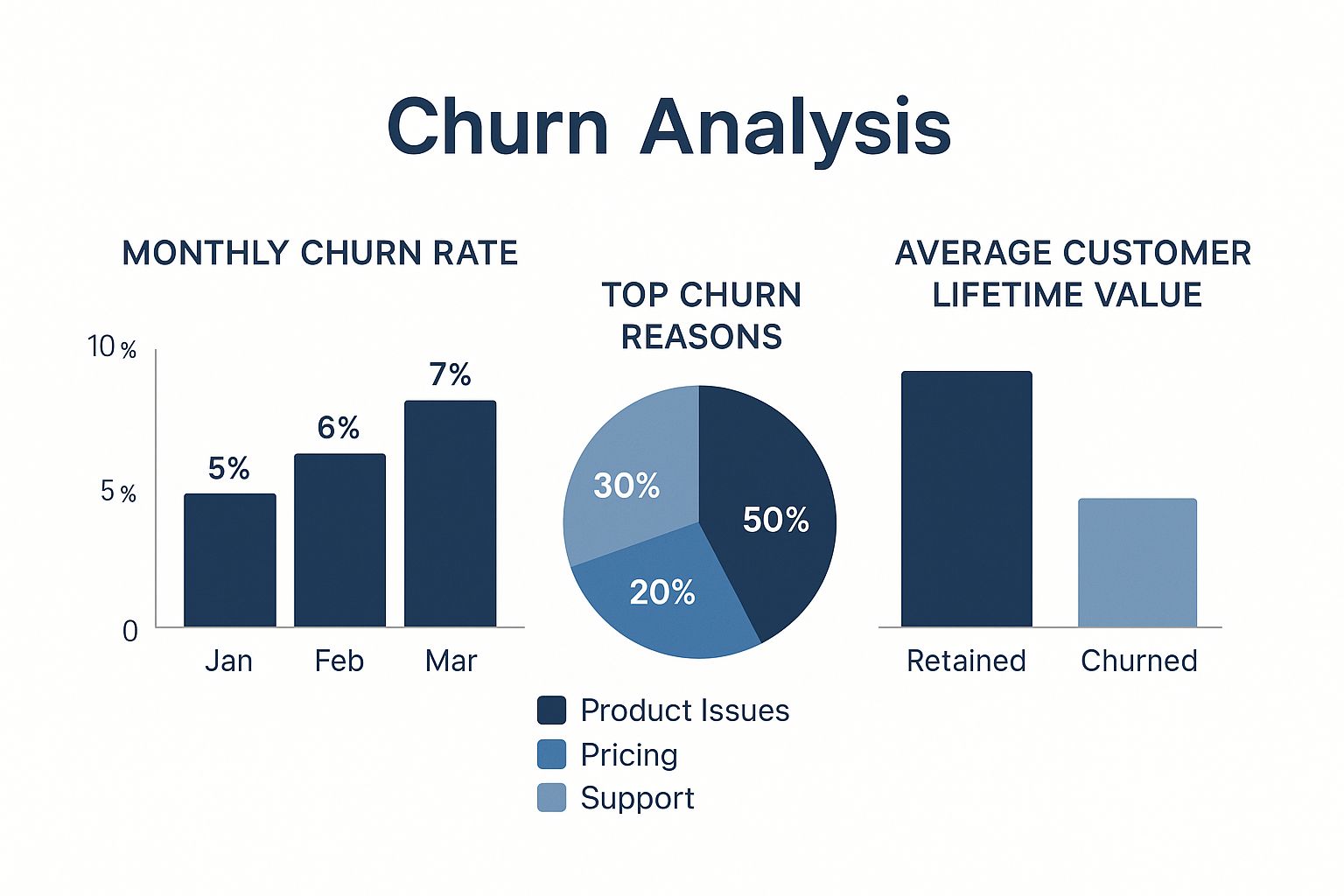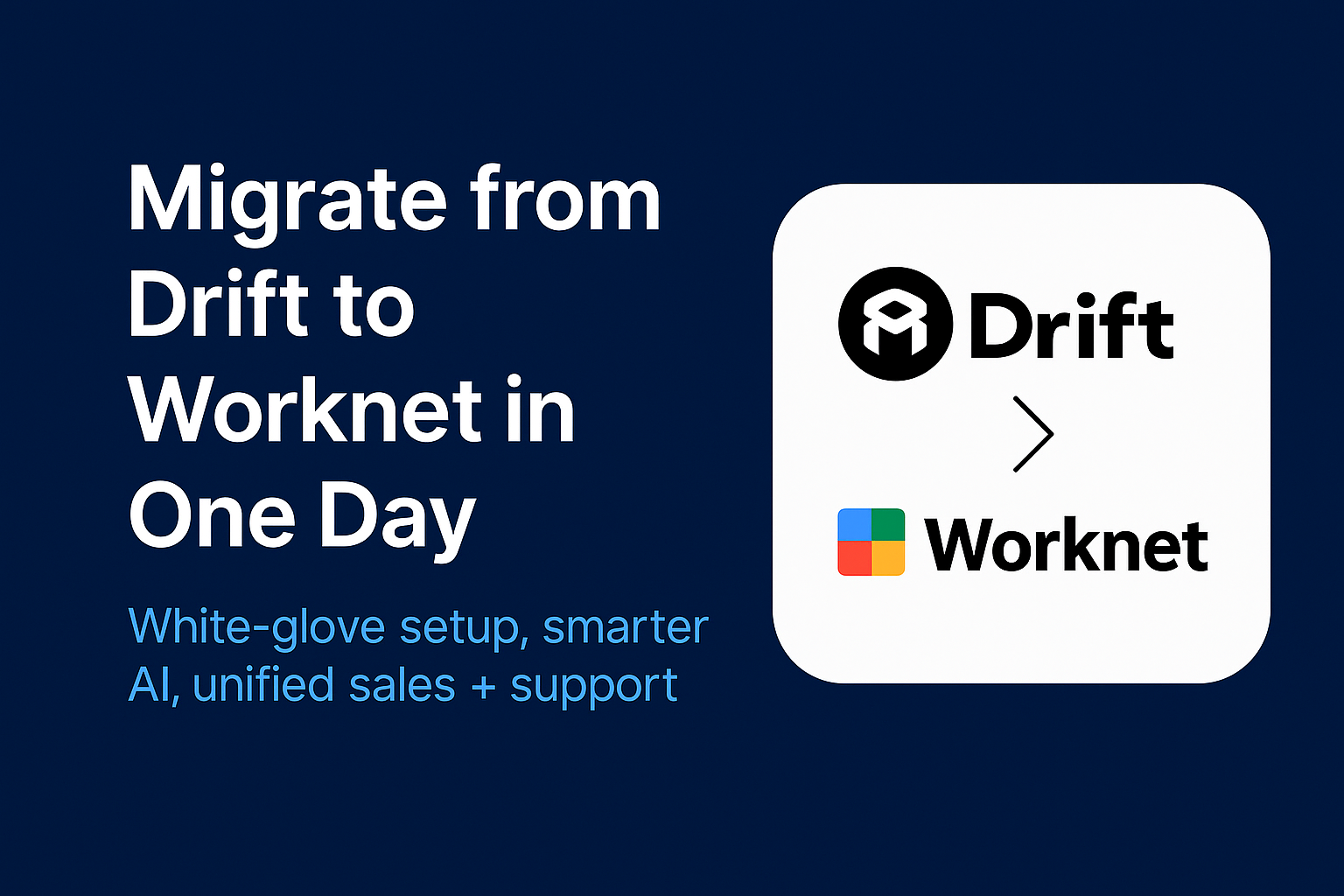How to Reduce Customer Churn: 8 Proven Strategies to Keep Your Customers
Understanding how to reduce customer churn starts with facing its true cost and figuring out exactly why customers are leaving. This isn't just about reacting when someone cancels. It’s about proactively creating a stellar user experience from day one—think seamless onboarding, personalized engagement, and support that’s always on the ball.
The goal is to shift from a reactive scramble to a proactive strategy, solving issues long before they become reasons to leave. By focusing on retaining the customers you’ve worked so hard to win, you build a stable revenue base and a foundation for sustainable growth.
The Sneaky, Compounding Cost of Customer Churn
Customer churn isn’t just another metric on your dashboard. It's a silent business killer, quietly draining your revenue and putting the brakes on growth. While the lost subscription fee is the obvious hit, the real damage is what's happening just below the surface. Every customer you lose carries a trail of hidden costs that ripple through your entire company.
Think about it: the biggest expense is the constant pressure it puts on your customer acquisition efforts. When churn is high, your marketing and sales teams are basically running on a treadmill. They're spending a fortune just to replace the customers walking out the back door. Your acquisition budget isn't fueling growth anymore; it's just plugging a leak in a sinking ship.
The Churn Snowball Effect
This is where the problem really compounds, and it's something people often underestimate. A seemingly small monthly churn rate can have a massive impact over a year.
To see how this plays out, let's look at a simple breakdown.
Monthly vs. Annual Churn Rate Impact
This table illustrates how a small monthly churn rate compounds into a significant annual loss of customers and revenue.
As you can see, a 5% monthly churn rate doesn't just mean you lose 5% of your customers. It means you lose nearly half (46%) of them over the course of a year. A 10% monthly rate becomes a catastrophic 70%+ loss annually. That means you might have to replace almost your entire customer base every single year just to break even. It's an exhausting and incredibly expensive cycle.
It's More Than Just Money
Beyond the financial drain, high churn is a morale killer. Your customer-facing teams—from support to success—are on the front lines, dealing with frustrated users day in and day out. It’s emotionally taxing and leads directly to burnout, which in turn hurts the quality of service for the loyal customers you still have.
At the same time, every customer who leaves is a potential bad review waiting to happen. They might share their negative experience online or with colleagues, slowly poisoning your brand's reputation and making it that much harder to attract new users.
The bottom line: Proactive retention isn’t a nice-to-have; it's the foundation of sustainable growth. By focusing on keeping the customers you’ve worked so hard to win, you build a stable revenue base, boost team morale, and protect your brand for the long haul.
This infographic breaks down some of the key numbers behind churn, showing how quickly it adds up and why it's so critical to address.

As the visual shows, product issues are often the biggest culprit behind churn, and the value of a customer who sticks around is exponentially higher than one who leaves early.
Putting Retention at the Core of Your Growth Strategy
For too many companies, the default is just to pour more money into the top of the marketing funnel. But real, sustainable success comes from a more balanced approach. The first step is truly understanding the compounding cost of churn and making retention a core part of your growth engine.
When you start seeing retention this way, your priorities naturally shift. You start investing more in:
- Understanding what customers are actually doing: You dig into the data to find the patterns and warning signs that show up right before someone cancels.
- Fixing the broken parts of your product: You get serious about addressing the friction points and bugs that cause the most frustration.
- Building real relationships: You make customers feel heard, valued, and supported throughout their journey with you.
Ultimately, tackling churn isn’t about a single magic trick. It's about a cultural shift toward putting the customer at the center of everything you do. Once you’ve confronted these hidden costs, you can explore proven strategies to reduce customer churn to build a tactical roadmap. This empowers you to make smarter investments in your product, your team, and your most valuable asset—your existing customers.
1. Find the Real Reasons Customers Leave

If you really want to plug the holes in your leaky bucket, you have to stop guessing why customers are leaving. It’s rarely one single, dramatic event. The decision to cancel is usually the final straw after a series of small frustrations, unmet needs, or a slow, dawning realization that they aren't getting the value they hoped for.
Simply staring at your overall churn rate tells you that you have a problem, but it offers zero clues about why.
Your first job is to become a churn detective. You need to investigate the scene, gather clues from different sources, and piece together the real story behind every cancellation. This means digging into both the hard numbers and the human stories.
Start by Segmenting Your Churned Users
Throwing all your churned users into one big bucket is a recipe for confusion. The reasons a small business on your basic plan leaves are likely worlds apart from why an enterprise client cancels. The real insights are hiding in the details.
By breaking down your churned users into smaller, more specific groups, you can finally start to see the patterns.
Try looking at your churned users through these lenses:
- By Subscription Plan: Are users on your entry-level plan churning at a much higher rate? Maybe they don't see enough value to justify the cost, or a critical feature is locked behind a higher tier.
- By Customer Tenure: Is churn spiking in the first 30 days? That screams onboarding issues. If they're leaving after a year, it could mean they've outgrown your tool or feel the value has faded over time.
- By Feature Usage: This is a big one. What features were they not using? If a customer never touches the one core feature that delivers that "aha!" moment, their departure is almost inevitable.
This kind of analysis transforms a vague problem into a specific, solvable one. You go from "Customers are leaving" to "New users on our 'Pro' plan who fail to adopt the reporting feature within 45 days are 80% more likely to churn." Now you have something you can actually fix.
Blend the "What" with the "Why"
Your product analytics and CRM data give you the "what"—the cold, hard facts. But numbers can't tell you about a user's frustration or disappointment. For that, you need to talk to them. This is where qualitative feedback becomes your superpower.
Here’s how to get those crucial insights:
- Exit Surveys: As soon as someone cancels, hit them with a simple, automated survey. Just one question: "What was the main reason you decided to cancel?" Keep it short and you'll get more responses.
- Personal Outreach: For high-value accounts, nothing beats a personal touch. A quick, genuine email or even a phone call from a customer success manager can uncover incredibly detailed feedback. It also shows you care, which can sometimes even win them back.
- Support Tickets: Your support logs are a treasure trove. They contain a running history of every friction point, bug, and confusing feature that slowly wore your customers down.
The real magic happens when you connect the qualitative "why" to your quantitative "what." When an exit survey says, "It was too complicated," and you can tie that to a user segment that never finished the setup wizard, you've found a root cause.
This investigative work is vital in every industry. Some sectors, like wholesale, can see churn rates as high as 56% due to fierce price competition and low switching costs. In those environments, consistent, direct communication is the only defense against churn.
Ultimately, diagnosing churn isn't a one-time project; it’s a continuous process. You need to build a feedback loop where the reasons people leave are used to make the experience better for the customers who stay. Stronger customer relationships are a direct byproduct of this attention to detail. To dig deeper into this, check out our guide on the importance of customer relationship building, which explains how these connections create a loyal user base.
Keep asking why, keep connecting the dots, and you can finally stop guessing and start fixing the real problems driving customers away.
2. Nail the Onboarding to Create Instant Stickiness

Let's be blunt: your customer's first impression is everything. Nowhere is that truer than in SaaS. A clunky, impersonal, or confusing onboarding experience is a primary reason users churn, often vanishing within the first 30 days. They signed up to solve a problem, and if they can't quickly see how your tool helps them do that, they'll lose steam and find a competitor who makes it easier.
The biggest mistake I see companies make is treating onboarding like a generic feature-dump. You can't just throw a checklist at new users and cross your fingers. Great onboarding isn't about showing off your product; it’s about getting the user to their first meaningful win—fast. This is their "aha!" moment, the instant they feel the value your product delivers.
To get this right, you have to stop "teaching features" and start "guiding to outcomes." Every single step in your onboarding flow needs to answer one question: does this get my user closer to solving their problem?
Ditch the Generic Product Tour
A one-size-fits-all product tour is dead on arrival. It assumes every user has the same job, the same goals, and the same level of tech-savviness. The secret to an onboarding experience that actually works is personalization and context. You need to understand why this specific person signed up and tailor their first few minutes accordingly.
This means swapping out old-school methods for dynamic, behavior-driven approaches.
- Interactive Walkthroughs: Forget passive, click-through tutorials. Guide users to complete actual tasks in your app. Instead of just showing them the "Create Report" button, have them build their first simple report.
- Behavior-Triggered Messages: Don't blast every user with the same pop-up. Use smart, in-app messaging that triggers based on actions (or a lack thereof). If a user creates a project but doesn't invite a colleague after 48 hours, a subtle nudge can prompt them to take that crucial next step.
- Personal Welcome Videos: An email from
no-reply@yourcompany.comfeels cold and corporate. A short, personal video from a customer success manager makes a massive difference. Tools like Loom or Vidyard make this surprisingly easy to do, building an immediate human connection.
I’ve seen it time and again: poor onboarding is a top driver of voluntary churn. When users can’t find that initial spark of value, they will abandon ship for a competitor who provides a clearer path to success. It's that simple.
Focus on That First "Aha!" Moment
The entire point of your onboarding is to shepherd every new user to their first taste of success. To do this, you have to know what that moment is for different user personas.
For a project management tool, the "aha!" moment might be seeing a teammate check off the first shared task. For an analytics platform, it could be discovering a surprising insight on their very first dashboard.
Once you’ve identified these key moments, you can reverse-engineer your entire onboarding flow to guide users straight to them.
Map Out a Guided Journey
Think of your onboarding as a structured, multi-stage journey, not a one-and-done event. A great flow often blends automated touchpoints with human interaction to keep users engaged and moving forward.
Here’s what that might look like:
This structured approach stops users from feeling overwhelmed and adrift. It gives them a clear path forward and shows you're invested in their success from the very beginning. By designing an onboarding experience that proves your product's value from day one, you do more than just reduce customer churn—you build the foundation for long-term loyalty and turn new users into your biggest fans.
3. Turn Your Customer Experience Into a Retention Magnet
In a crowded market, your features can be copied and your pricing can be undercut. The one thing that truly sets you apart—and acts as your strongest defense against churn—is your customer experience. It only takes one frustrating interaction to undo months of loyalty you’ve worked hard to build.
To really tackle churn, you have to stop thinking of customer experience as a reactive support function. It needs to become your proactive retention engine. This means getting ahead of problems and creating a support system so seamless that users barely notice it. A great experience doesn't just solve a problem; it strengthens the entire relationship.
The financial stakes here are massive. Poor customer experiences are a huge reason customers leave, costing U.S. businesses roughly $136.8 billion every year from churn that could have been avoided. The numbers don't lie: 59% of customers will ditch a brand after a few bad experiences, and a shocking 17% will walk away after just one negative event. On the flip side, improving the customer experience can directly cut churn by as much as 15%.
Ditch Reactive Support for a Proactive Approach
Most support teams are trapped in a reactive cycle, only stepping in after a customer has already hit a wall and reported a problem. By that point, the damage is done. The best companies completely flip this model around. They anticipate customer needs and offer help before the frustration even begins.
This isn't about psychic powers; it's about using data to spot the early warning signs.
- Watch how people use your product. Are they clicking the same button over and over, hinting at confusion? Did they start a key workflow but never finish it? These are perfect moments for a well-timed in-app message or a friendly email offering some guidance.
- Give a clear heads-up about changes. Before you roll out a big update that changes the UI or removes a feature, tell your customers. A simple announcement with helpful resources can prevent a flood of confused and angry support tickets.
- Celebrate their wins. Acknowledge when a customer hits their one-year anniversary or reaches a big usage milestone. It’s a small gesture, but it makes them feel seen and valued, reinforcing their decision to stick with you.
When you get ahead of issues like this, you’re not just solving problems—you’re preventing them from ever happening. This fundamentally shifts how customers see your brand, from a simple tool to a supportive partner in their success.
Empower Your Support Team to Be Heroes
Your customer support team is on the front lines every single day. No one in your company has more direct contact with your users. Treating them as mere ticket-closers is a colossal missed opportunity. They should be empowered as genuine problem-solvers and relationship-builders.
Don't tie your support team's hands with rigid scripts and limited authority. Give them the flexibility and autonomy to do what's right for the customer, even if it means bending the rules now and then.
Imagine a support agent who can issue a small credit, extend a trial, or offer a sincere apology without needing three levels of approval. They can turn a furious customer into a lifelong advocate in a single conversation. This kind of autonomy not only skyrockets customer loyalty but also boosts morale and reduces burnout on your own team.
Build a Feedback System That Actually Listens
Your customers are giving you feedback constantly, whether it's through support tickets, reviews, or social media posts. The real question is: are you actually listening? A solid feedback system is more than a digital suggestion box; it's a closed-loop process that proves to customers that you're paying attention.
Here's how to build one that truly works:
- Acknowledge every single piece of feedback. Good or bad, let the customer know you got their message and thank them for taking the time.
- Get the feedback to the right people. A bug report needs to go straight to the engineering team. A feature request should be logged for the product managers to review.
- Close the loop. This is the most important step, and the one most companies miss. When you finally fix a bug a customer reported or launch a feature they asked for, reach out and let them know.
That last step is incredibly powerful. It shows customers their voice truly matters and that they are actively helping shape your product's future. It transforms them from passive users into active partners, building a kind of deep-seated loyalty that competitors can't touch. For more actionable advice on this, see our detailed guide on how to improve customer satisfaction. An exceptional experience isn't just a nice-to-have; it's your most sustainable growth strategy.
4. Deploy Retention Campaigns That Actually Work

Alright, let's get tactical. You've dug into the data to see why customers are bailing, and you've started patching the holes in their experience. Now it's time to roll out targeted retention campaigns that actively keep people engaged and happy. These aren't just generic marketing blasts—we're talking about specific, data-backed efforts that intervene at just the right moment.
The idea is to shift from being reactive to proactive. Instead of getting a cancellation notice and scrambling, you're spotting at-risk users early and giving them a compelling reason to stick around. This is where your customer data and smart segmentation really shine.
Spot At-Risk Customers Before They're Gone
You can't save a customer you don't even know is unhappy. The first real step here is learning to spot the early warning signs of churn. This usually means creating a customer health score, which is just a fancy way of saying you combine a few key behaviors into a single metric that tells you, at a glance, how an account is doing.
This score is your tripwire. When it drops, it’s a clear signal that a customer’s engagement is fading. Some of the most telling indicators to track are:
- Decreased Login Frequency: Someone who used to log in every day is now showing up once a week. Big red flag.
- Reduced Feature Usage: They've stopped using the core features that made your product a must-have for them in the first place.
- Unresolved Support Tickets: Nothing sours a relationship faster than a problem that just sits there, unresolved.
- Negative Feedback: This one's a gimme. Low NPS or CSAT scores are a direct cry for help.
By keeping an eye on these metrics, you can set up automated alerts for your customer success team the moment a health score dips. This lets them jump in with a helpful hand before the user even starts looking for the exit.
Run Targeted Re-Engagement Campaigns
Once you’ve identified a segment of users who have gone quiet, it’s time to nudge them back to life with a re-engagement campaign. But a generic "We miss you!" email is a waste of a send. Your outreach has to be personal and show them the value they're missing, reminding them why they signed up to begin with. Digging into proven retention strategies can give you some fantastic ideas that have worked in other industries, too.
Here are a few campaign ideas that tend to get results:
- The "New Feature" Nudge: See a user who hasn't logged in for a while? Hit them with an email showcasing a new feature that's directly related to what they used your product for.
- The "Case Study" Reminder: Share a success story from a company in their industry. It’s a powerful, low-pressure way to show them the value they could be getting.
- The "Personal Check-In": For your high-value accounts, nothing beats a simple, personal email from a customer success manager asking if they need a hand with anything. It’s surprisingly effective.
Key Takeaway: Personalized re-engagement campaigns work because they prove you're paying attention. We're talking 29% higher open rates and 41% higher click-through rates on personalized emails—numbers that are too good to ignore when trying to get a quiet user's attention.
Implement Smart Offers and Incentives
Sometimes, a well-timed offer is all it takes to stop churn in its tracks, especially for customers who are more sensitive to price. But you have to be careful here; throwing discounts around like confetti just devalues your product. The key is to be strategic.
Here’s a simple framework for making offers that actually solve the problem:
The point is to match the incentive to the situation. A discount won’t fix a poor product fit, but it might be the perfect save for a budget-strapped customer who truly loves what you do.
Always Measure Your Campaign ROI
Launching campaigns without tracking their impact is just guessing. You need to know if your efforts are actually paying off, and that means measuring the return on investment (ROI) for every single retention initiative.
A/B testing is your best friend here. For instance, send a special discount offer to one group of at-risk users and a simple, personal check-in email to another. Then, watch the churn rate for both groups over the next 30 to 60 days.
This data will tell you exactly which campaigns are moving the needle. It lets you double down on what works and ditch what doesn’t. This constant loop of testing, measuring, and iterating is what turns churn reduction from a guessing game into a data-driven science. For more on this, check out our other guide to boost your customer retention with these kinds of proactive strategies.
Answering Your Toughest Customer Churn Questions
As you dig into reducing customer churn, you're bound to have questions. Let's tackle some of the most common ones I hear from SaaS leaders, moving past the theory and into what actually works in the real world.
What is a good customer churn rate?
This is the million-dollar question, and the honest answer is: it depends. If you're a SaaS serving small and medium-sized businesses (SMBs), a monthly churn rate between 3-5% is generally considered acceptable. For companies working with large enterprise clients, that number needs to be way lower, ideally under 1%.
But getting fixated on an industry benchmark is a trap. I've seen too many founders chase a "magic number" instead of focusing on their own trajectory.
The most important metric isn't how you stack up against a competitor; it's your own month-over-month progress. The real goal is simple: make that churn line trend downwards, consistently.
How can I predict which customers are about to churn?
You don't need a crystal ball to see churn coming. You just need to pay attention to the right signals. Predicting churn is all about spotting the behavioral red flags that show up long before a customer clicks "cancel."
Keep a close eye on these leading indicators:
- Login frequency plummets. A daily user who suddenly only logs in once a week is waving a red flag.
- Core feature usage drops. Are they no longer using the sticky features that solve their biggest problems?
- Support tickets go silent or pile up. A history of ignored tickets is a clear sign of frustration.
- They downgrade their plan. Removing add-ons or moving to a lower tier often precedes a full cancellation.
- They're ignoring you. No engagement with new feature announcements or your educational content means they've mentally checked out.
Track these behaviors to build a customer health score. When that score dips, it’s your cue for the customer success team to jump in and find out what's wrong—before it’s too late.
Should I offer discounts to customers who want to cancel?
Offering a last-ditch discount is tempting. It feels like a quick save, but it's usually just a short-term patch that papers over a bigger crack. It’s a classic double-edged sword.
Sure, if a customer is leaving purely for budget reasons, a temporary price cut might keep them around. But more often than not, the problem runs deeper. Maybe your product isn't delivering value, they've had a bad support experience, or a competitor is simply a better fit. A discount won't fix any of that, and they'll likely leave as soon as the promotional period ends.
A much better strategy is to treat the cancellation request as an invaluable feedback session. Before you even think about a discount, find out why they want to leave. Maybe you can offer to pause their subscription for a couple of months. Or perhaps a one-on-one session to help them master a feature they're struggling with is the real answer. These approaches solve the actual problem instead of just kicking the can down the road.
For more fresh perspectives on customer engagement and growing your business, the folks over at Screencharm's Blog often have some great insights.
At Worknet.ai Inc, we believe proactive engagement is the key to retention. Our AI-powered chat helps you guide users from their first visit through onboarding and beyond, answering questions and providing support 24/7. Transform your customer journey and turn more trials into loyal, long-term customers. Learn how at https://worknet.ai.
FAQs
.png)
Lorem ipsum dolor sit amet, consectetur adipiscing elit. Suspendisse varius enim in eros elementum tristique. Duis cursus, mi quis viverra ornare, eros dolor interdum nulla, ut commodo diam libero vitae erat. Aenean faucibus nibh et justo cursus id rutrum lorem imperdiet. Nunc ut sem vitae risus tristique posuere.
Lorem ipsum dolor sit amet, consectetur adipiscing elit. Suspendisse varius enim in eros elementum tristique. Duis cursus, mi quis viverra ornare, eros dolor interdum nulla, ut commodo diam libero vitae erat. Aenean faucibus nibh et justo cursus id rutrum lorem imperdiet. Nunc ut sem vitae risus tristique posuere.
Lorem ipsum dolor sit amet, consectetur adipiscing elit. Suspendisse varius enim in eros elementum tristique. Duis cursus, mi quis viverra ornare, eros dolor interdum nulla, ut commodo diam libero vitae erat. Aenean faucibus nibh et justo cursus id rutrum lorem imperdiet. Nunc ut sem vitae risus tristique posuere.
Lorem ipsum dolor sit amet, consectetur adipiscing elit. Suspendisse varius enim in eros elementum tristique. Duis cursus, mi quis viverra ornare, eros dolor interdum nulla, ut commodo diam libero vitae erat. Aenean faucibus nibh et justo cursus id rutrum lorem imperdiet. Nunc ut sem vitae risus tristique posuere.
Lorem ipsum dolor sit amet, consectetur adipiscing elit. Suspendisse varius enim in eros elementum tristique. Duis cursus, mi quis viverra ornare, eros dolor interdum nulla, ut commodo diam libero vitae erat. Aenean faucibus nibh et justo cursus id rutrum lorem imperdiet. Nunc ut sem vitae risus tristique posuere.
Lorem ipsum dolor sit amet, consectetur adipiscing elit. Suspendisse varius enim in eros elementum tristique. Duis cursus, mi quis viverra ornare, eros dolor interdum nulla, ut commodo diam libero vitae erat. Aenean faucibus nibh et justo cursus id rutrum lorem imperdiet. Nunc ut sem vitae risus tristique posuere.
Lorem ipsum dolor sit amet, consectetur adipiscing elit. Suspendisse varius enim in eros elementum tristique. Duis cursus, mi quis viverra ornare, eros dolor interdum nulla, ut commodo diam libero vitae erat. Aenean faucibus nibh et justo cursus id rutrum lorem imperdiet. Nunc ut sem vitae risus tristique posuere.
Lorem ipsum dolor sit amet, consectetur adipiscing elit. Suspendisse varius enim in eros elementum tristique. Duis cursus, mi quis viverra ornare, eros dolor interdum nulla, ut commodo diam libero vitae erat. Aenean faucibus nibh et justo cursus id rutrum lorem imperdiet. Nunc ut sem vitae risus tristique posuere.
Lorem ipsum dolor sit amet, consectetur adipiscing elit. Suspendisse varius enim in eros elementum tristique. Duis cursus, mi quis viverra ornare, eros dolor interdum nulla, ut commodo diam libero vitae erat. Aenean faucibus nibh et justo cursus id rutrum lorem imperdiet. Nunc ut sem vitae risus tristique posuere.
Lorem ipsum dolor sit amet, consectetur adipiscing elit. Suspendisse varius enim in eros elementum tristique. Duis cursus, mi quis viverra ornare, eros dolor interdum nulla, ut commodo diam libero vitae erat. Aenean faucibus nibh et justo cursus id rutrum lorem imperdiet. Nunc ut sem vitae risus tristique posuere.

.svg)


.webp)
.webp)
.webp)





